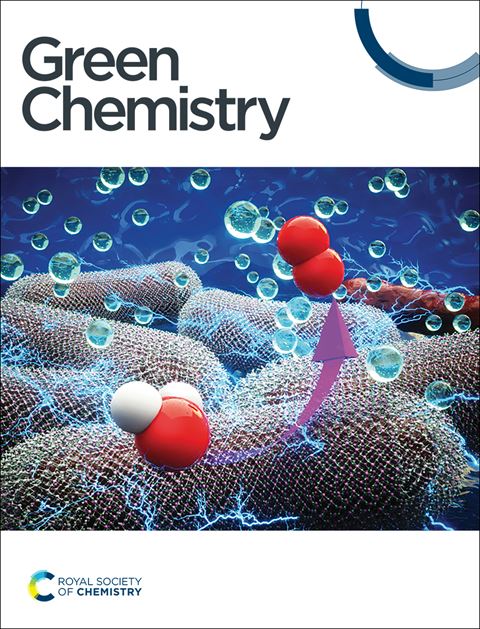Production of high-carbon-number hydrocarbon bio-aviation fuels via catalytic hydrogenation of vanillin and non-catalytic condensation: a mechanistic study with DFT and experimental insights†
IF 9.2
1区 化学
Q1 CHEMISTRY, MULTIDISCIPLINARY
引用次数: 0
Abstract
Lignocellulose or lignin present significant potential as sustainable feedstocks to replace petroleum-derived resources through catalytic upgrading. Hydrodeoxygenation of phenolic molecules derived from lignocellulose or lignin can produce cycloalkanes, but often forms low-carbon-number hydrocarbons, which are more suitable for gasoline rather than high-carbon-number diesel or aviation fuels. This study investigates the production of high-carbon-number hydrocarbons in the aviation fuel range from lignin-derived compounds, using vanillin as a model. A two-step process was performed to achieve this: selective hydrogenation of vanillin to vanillyl alcohol and creosol using 1 wt% ruthenium on carbon, followed by non-catalytic condensation and subsequent hydrodeoxygenation of the condensates to cycloalkanes using 3 wt% ruthenium on HZSM-5. This process yielded C14 aviation fuel precursor (19%) and C14 deoxygenated hydrocarbon (5%) whereas the one-step process without the condensation step did not yield any C14 compounds. The reaction pathway was elucidated through density functional theory calculations and control experiments with intermediates, providing insights into the mechanisms of upgrading lignin-derived compounds for sustainable aviation fuel production.
通过香兰素催化加氢和非催化缩合生产高碳数碳氢化合物生物航空燃料:用DFT和实验见解进行的机理研究
通过催化升级,木质纤维素或木质素具有替代石油衍生资源的可持续原料的巨大潜力。木质纤维素或木质素衍生的酚类分子加氢脱氧可以产生环烷烃,但通常形成低碳数的碳氢化合物,这种碳氢化合物更适合用于汽油而不是高碳数的柴油或航空燃料。本研究以香兰素为模型,研究了木质素衍生化合物在航空燃料范围内生产高碳数碳氢化合物的过程。为了实现这一目标,采用了两步工艺:在碳上使用1 wt%的钌选择性地将香兰素加氢为香兰醇和甲酚,然后在HZSM-5上使用3 wt%的钌将缩合物加氢脱氧为环烷烃。该工艺产C14航空燃料前体(19%)和C14脱氧烃(5%),而不含缩合步骤的一步法不产C14化合物。通过密度泛函理论计算和中间体控制实验,阐明了反应途径,为木质素衍生化合物的可持续航空燃料生产机制提供了新的见解。
本文章由计算机程序翻译,如有差异,请以英文原文为准。
求助全文
约1分钟内获得全文
求助全文
来源期刊

Green Chemistry
化学-化学综合
CiteScore
16.10
自引率
7.10%
发文量
677
审稿时长
1.4 months
期刊介绍:
Green Chemistry is a journal that provides a unique forum for the publication of innovative research on the development of alternative green and sustainable technologies. The scope of Green Chemistry is based on the definition proposed by Anastas and Warner (Green Chemistry: Theory and Practice, P T Anastas and J C Warner, Oxford University Press, Oxford, 1998), which defines green chemistry as the utilisation of a set of principles that reduces or eliminates the use or generation of hazardous substances in the design, manufacture and application of chemical products. Green Chemistry aims to reduce the environmental impact of the chemical enterprise by developing a technology base that is inherently non-toxic to living things and the environment. The journal welcomes submissions on all aspects of research relating to this endeavor and publishes original and significant cutting-edge research that is likely to be of wide general appeal. For a work to be published, it must present a significant advance in green chemistry, including a comparison with existing methods and a demonstration of advantages over those methods.
 求助内容:
求助内容: 应助结果提醒方式:
应助结果提醒方式:


